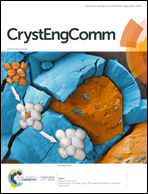Predicting the crystal habit of photoinitiator XBPO and elucidating the solvent effect on crystal faces†
Abstract
The crystal habits of bis(2,4,6-trimethylbenzoyl)phenylphosphine oxide (XBPO) were predicted by considering solvent effects using a modified attachment energy model. The electrostatic potential (ESP) slices of important crystal faces were determined to explore the surface features of the crystal. The hydrogen bonding forming ability of solvents was investigated by the radial distribution function at the molecular level. Besides, an affinity degree model was first introduced to elaborate the solvent effect on crystal faces. Results indicate that the different affinity degrees for solvent molecules at the face can lead to the dissimilarity of the face in morphological importance. Meanwhile, the crystals were prepared in acetone and ethanol solvents by adopting the slow solvent evaporation method. The experimental results were highly in accordance with the simulated crystal morphology. Overall, this work could be helpful to better understand the habits of crystals induced by solvents and to have clear guidance for screening solvents to acquire crystals with desired morphologies in the crystallization process.



 Please wait while we load your content...
Please wait while we load your content...